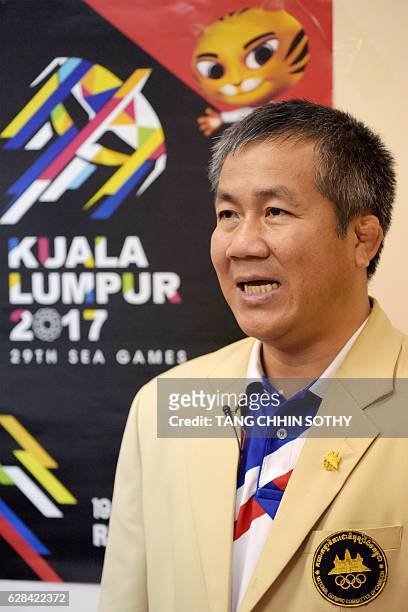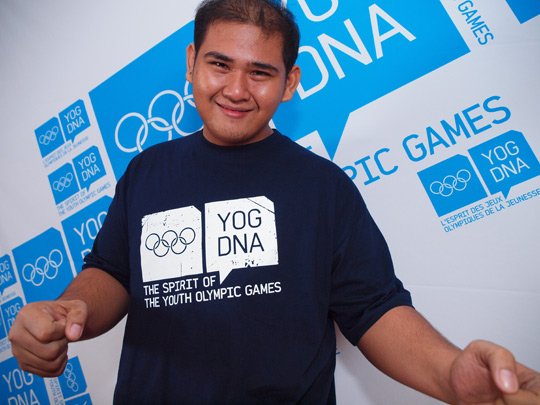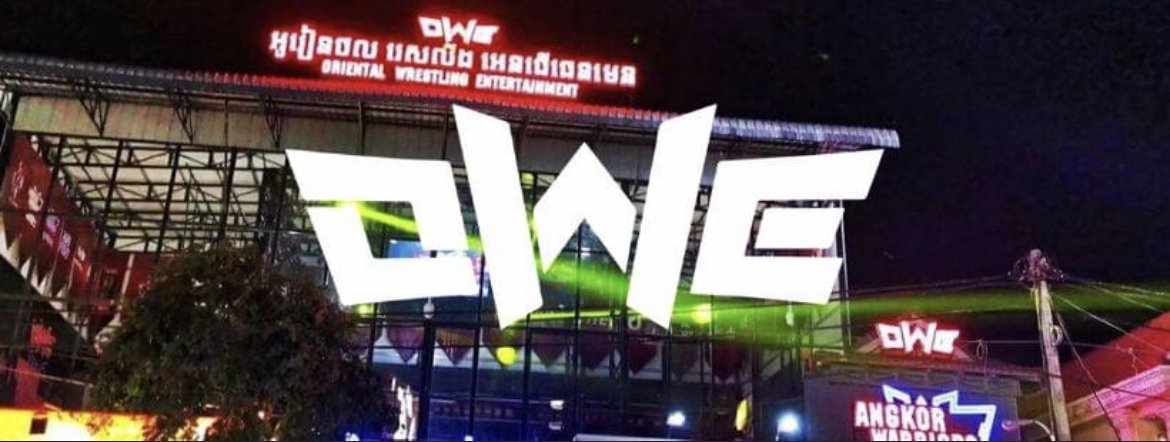A national pro wrestling team? The story of Cambodia’s olympic hopefuls that cross trained in the professional sport
The unique case of the first ever national pro wrestling team and the mystery of its sudden disappearance.
There are plenty of examples of amateur wrestlers turning pro following a successful career on the amateur mats. There are even examples of wrestlers who competed for their national team in international competition who would eventually give pro wrestling a shot. Two examples that quickly come to mind are Kurt Angle and Jeff Cobb. However, as far as I’m aware, there has never been any examples of a national pro wrestling team. That is, a team of a nation’s best wrestlers representing their country in the professional game. Well, except for one time. Let me explain.
It all started in December 2006 in Phnom Penh, the capital and largest city in Cambodia, and also the location of the Cambodian national wrestling team’s headquarters. After seeing the popularity of American wrestling programs in Cambodia including WWE Smackdown, Vath Chamroeun, Cambodia’s first ever Olympic wrestler and the Secretary General of Cambodia’s national wrestling team at the time, saw dollar signs.
As Emily Lodish reported on March 23rd, 2007 for The Cambodia Daily, Vath Chamroeun developed an idea over the course of several years that would finally be put into practice in December 2006. The wrestling moves that the Cambodian fans loved to watch on television could easily be replicated by the national amateur team’s wrestlers, Vath Chamroeun believed. Plus, a foray into the pro wrestling business would make the national team wrestlers stars and could make the program additional money, an opinion shared by Cambodian national team coach Hok Chheang Kim.
Vath Chamroeun
December 2006 would mark the start of the ambitious Cambodian pro wrestling program. Sixteen wrestlers, including ten men and six women, were part of the original group to incorporate pro wrestling training into their daily workout sessions with the national team. Part of this training included work focused on the wrestlers’ acting skills, led by Vath Chamroeun. The acting portion of training would last for ten to fifteen minutes each day, with the goal to make the wrestlers more believable and focused on learning acting skills such as how to better portray anger on their face.
Vath Chamroeun also shared some pro wrestling insider secrets with the trainees, tricks of the trade that he claimed to have picked up from Japanese pro wrestlers while visiting North Korea in the 1990’s. With North Korea having a strongly established wrestling program and Cambodia sending a wrestler to the Olympics for the first time, along with the positive relationship that exists between the two nations, Chamroeun spent time training in North Korea for the 1996 Olympic Games that were held in Atlanta, Georgia. This timetable seems to line up with the New Japan/WCW Collision in Korea event, which took place in April 1995. It’s entirely possible that Vath could have been on hand for the event, possibly with access to New Japan talent, especially if he was training with the North Korean olympic amateur team at that time.
By March of 2007, Cambodia’s new pro wrestlers had competed in at least two events at Olympic Stadium in Phnom Penh. I haven’t been able to track down any footage of these events or any more information on them but it’s possible that they were part of a kickboxing card or amateur wrestling tournament, events that the pro style had been featured on before.
Olympic Stadium in Phnom Penh, Cambodia. Image courtesy of the National Olympic Stadium of Cambodia Facebook Page.
October 1st, 2008 would mark the first time the national pro wrestling team would head out on the road for a performance. This came in the form of an event in Vihear Suor village in Kandal province as part of the P'Chum Ben Festival celebrations. Six wrestlers were on hand at the show with wrestlers Giant Vinn and Chab Leun being mentioned as part of a report by The Phnom Penh Post on the bouts. The wrestlers were set for another event at Olympic Stadium in November 208, competing on the undercard of a Cambodian Bokator (which is a traditional form of Cambodian kickboxing) event at their familiar stomping grounds of Olympic Stadium, as per the Phnom Penh Post.
2009 was a landmark year for Cambodia’s pro wrestlers. That year, the wrestlers took to the beach in Sihanoukville for a live, in ring performance. This event would serve as the creation of a television program that would air on Cambodian television. This is the only televised event I was able to track down featuring these wrestlers outside of the 2010 Water Festival, which I’ll touch on later. I was unable to track down a date for this taping other than the year and location and as for the wrestlers involved, the only one that I feel comfortable confirming is Giant Vinn who had been recognized numerous times in all press reports on Cambodia’s wrestlers as being by far the largest wrestler of the group.
This nearly half hour of programming featured some vignettes with the wrestlers, one of Cambodia’s female wrestlers in action and a six man tag team match that served as the main event. Giant Vinn once again played a big role, this time dominating throughout a large portion of the main event before being pinned.
Giant Vinn, real name Chum Chivinn, in his role as Cambodia’s Young Ambassador for the 2010 Youth Olympic Games in Singapore. Image courtesy of Olympics.com
Getting the Cambodian pro wrestlers on television was a major goal set by Vath Chamroeun and Hok Chheang Kim when starting the program. Accomplishing it after just three years must have felt rewarding and would help set the table for their biggest event yet. But it also makes what happened after this major event all the more unexplainable and mysterious.
The stage was now set for a big time event. This came over a two day period in November 2010, from the 20th to the 21st at Bon Oum Tok, the Cambodian Water Festival. The Water Festival is an annual celebration to mark the end of monsoon season, and consistently draws millions each year to the Cambodian capital of Phnom Penh.
The Water Festival show came with some of the biggest opportunities for Cambodian pro wrestling. The wrestling portion of the Water Festival was included as part of a concert presented by the company Nokia. A big audience turned out to watch the wrestling action, which for the first time included some foreign talent competing along with the Cambodian wrestlers. Despite the Cambodian National Olympic Committee’s frantic attempts, they were unable to bring in John Cena for the event. However, an experienced crew of joshi wrestlers consisting of Kyoko Inoue, Ayako Sato, Keiko Aono and Kaoru Ito were in action on the show, getting a great reaction from the Cambodian fans on hand in their match that opened the wrestling portion of the concert.
The four Joshi wrestlers that were part of the 2010 Water Festival event. From left, Kyoko Inoue, Ayako Sato, Keiko Aono and Kaoru Ito.
One big change for the Cambodian wrestlers heading into this event was that their group finally had a promotion name to hold all of their events under. Pro wrestling by the Cambodian crew would now be taking place under the banner of Cambodia Champion Association Wrestling Entertainment, also known as CCAWE. Not only would this event officially establish the CCAWE as an active pro wrestling company, it would also see the CCAWE crown their first ever champion and Cambodia’s first ever pro wrestling champion. But more on that in just a little bit.
The action from the Nokia Concert was caught in full and lives on today on YouTube. It’s actually pretty tough to track down, but we saved everything from the festival in a YouTube playlist titled “Cambodian Pro Wrestling” which you can easily access from the WrestleMap YouTube account. We also grabbed some clips which you can see when we release our video version of this piece.
At this point, the CCAWE crew was down to six Khmer pro wrestlers. Giant Vinn appears to have hung up his boots by this point, leaving Cambodia without their biggest and most recognizable talent. The wrestlers in action at Water Fest included Nuth Sophol (The Copper Mouse), Doon Sorsav (The Rock Garuda), Chap Lourn (Iron H), Thin Vibol, Thin Victheth, and Ngoun Kimheng, one of which wrestled as High Man.
Poster from the 2010 CCAWE Water Festival event
After two days of competition, the CCAWE Championship was on the line in a four way elimination match between The Copper Mouse, The Rock Garuda, Iron H and High Man. Wrestlers were eliminated from the match when they were pushed out of the ring and touched the floor until the final fall. The Rock Garuda withstood a brutal looking power bomb that landed him on his head and clinched the CCAWE Championship after drilling a solid dominator/roshambo. The Rock Garuda would celebrate his title victory as pyrotechnics went off, creating one of the few iconic images of Khmer pro wrestling that still lives on at least on the internet to this day.
Unfortunately, on the the third day of Bon Oum Tok in 2010, tragedy struck. A stampede on the bridge between Phnom Penh and Diamond Island caused the untimely death of 351 festival goers and the injury of 395 more. The wrestling events had wrapped up by this point and it’s unclear if any of the wrestlers or fans that attended the wrestling show were involved in this tragedy.
Over the course of the two day wrestling event at the Nokia Concert, the fan turn out was solid as was the reception from the crowd and the pyro and production looked like it would belong at any other pro wrestling event around the world. The action in the ring was passable as well, with the four plus years of training up to this point paying off with the results on display at Water Festival. The Water Festival and the reception it received, as well as the major love Cambodian fans had for WWE at this time, made it clear that there was a market for pro wrestling in Cambodia. Which makes the follow up to the Water Festival and the future of Cambodian pro wrestling even more confusing. It kind of just…disappeared without a trace.
The only known Cambodian pro wrestling champion, The Rock Garuda, with the CCAWE title belt.
Following The Rock Garuda’s CCAWE Championship win, any mention of Khmer pro wrestling completely disappeared from the Cambodian press. One article posted as a follow up to the Water Festival event questioned who The Rock Garuda would defend his title against first. But it doesn’t appear as if that title defense ever happened. Another article published in 2014 discussed how Cambodia “used to” have its own pro wrestling. So what happened?
Unfortunately, it remains a complete mystery. I’ve reached out to several people to try and get an explanation or a recap of what went down. I’ve talked with members of the Cambodian press that covered the national pro wrestling team, reached out to the national amateur wrestling program, tracked down some of the wrestlers involved and reached out to them and even attempted to speak directly with the father of the whole program and Cambodia’s first ever Olympic wrestler, Vath Chamroeun.
The press contacts were the most helpful, assisting with connecting me to multiple people, all of which had no idea what happened to the program. None of the former pro wrestlers that I reached out to responded to my inquiries. I was able to get in direct contact with Vath Chamroeun and even got a brief reply and introduction, but any inquiry into the pro wrestling program went unanswered.
Outside of the venue at OWE’s residence in Siem Reap. Image courtesy of the OWE Angkor Warriors Facebook page.
Of all the research I’ve done, everything I’ve read indicates that there is a very solid fan base for pro wrestling in Cambodia. It’s unfortunate that the only national pro wrestling team I’ve ever encountered couldn’t make it work in a country with a hunger for professional wrestling.
Following the disappearance of the national pro wrestling team, pro wrestling would return to Cambodia in late 2019 in the city of Siem Reap for a short lived run from Chinese pro wrestling company Oriental Wrestling Entertainment. Unfortunately, the run in Cambodia would only last until June 2020 and OWE would go out of business shortly after.
If you or anyone you know has any information on the fate of Cambodia’s national pro wrestling program or any other details on pro wrestling in Cambodia, please reach out to WrestleMap by email at WrestleMap@gmail.com.







